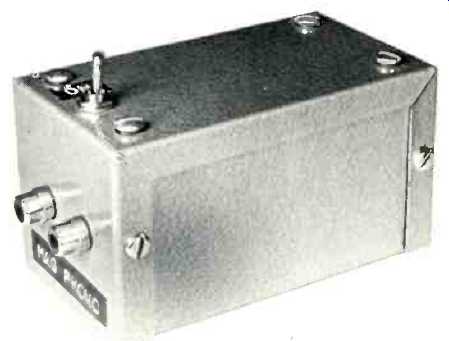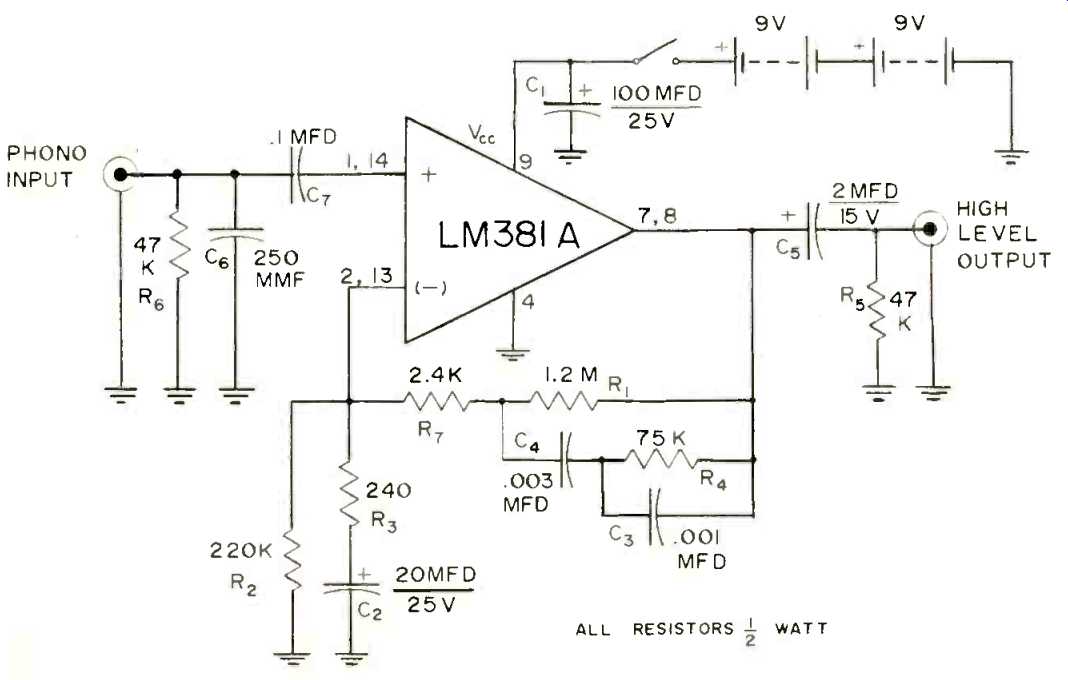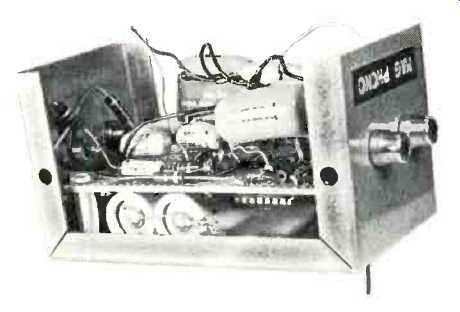by James P. Holm
YOUR AMPLIFIER has at least two noise specifications. The PHONOGRAPH input is usually rated at -60 to 65 decibels (dB) below 10 millivolts and high level inputs such as TUNER and AUX at -70 to -75 dB below 0.25 volts. On occasion, a third noise level will be listed, volume control in minimum position, about -90 dB referred to rated output. These figures indicate how wide your amplifier can open the "Dynamic Range Window" for the various signal sources presented to it.

Until now, the -65 dB figure for PHONO was sufficient, however, new phono records are being mastered using the Dolby "A" tape system and pressed on the quieter "skinny discs" making many amplifiers obviously deficient since audible background hiss remains after the phono pickup has been lifted from the record. This noise situation is further aggravated by the fact that the output of the very best phono cartridges is significantly less that of the poorer quality phono cartridges in the same product line. The person who is shooting for a really quiet high quality phono system is put in a bind as to the best mix of components for his particular needs since -78 dB preamplifiers are currently selling for a half kilo-buck. In the past, the author's policy has been "Damn the noise, full fidelity ahead!"
But no more. In an effort to capture he stereo preamplifier parts market, National Semiconductor has come up with an integrated circuit rated at 0.5 microvolts input noise. This is three to five times quieter than most pre-amplifiers made with discrete components. National's LM 381A chip can be made o deliver a peak-to-peak output voltage of 38 volts from a +40 volt supply. It also features cross-channel isolation of better than 60 dB from 20 to 20,000 Hz. This is achieved by an individual internal power supply decoupler-regulator or each channel. The regulator also provides 120 dB power supply noise rejection.
To exploit this integrated circuit efficiently, one merely builds it into a small phono preamplifier and drives one of the HIGH-LEVEL inputs on his existing amplifier with it. This should produce a phono playback system with a dynamic range window about 75 to 80 dB wide--even with a top quality phono cartridge.
Building up the preamplifier as an auxiliary component, the author used the phono circuit as published by National and modified it to suit his particular needs and tastes (see Fig. 1). Since no particular good comes from having a 38 volt signal going into a 2 volt HIGH-LEVEL input, the source voltage was reduced to 18 volts which still provides better than 5 volts before clipping. The 18 volts comes from two 9-volt transistor radio batteries-a source long known for its ripple-free output. The 100 uF buffer capacitor (C1) and the internal regulators should keep the distortion low until the batteries get extremely weak.

Fig. 1--Modified phono circuit as published by National using the LM381A
IC.
The LM 381A is an operational amplifier having differential inputs. The phono cartridge is connected to the input that is in phase with the output (the noninverting or + input). The amplification process is controlled by connecting the output back into an input that is 180° out of phase with the output (the inverting or (-) input). By being able to cancel out its own input, the amplifier can control its own sensitivity (negative feedback). By adding capacitors to the feedback resistors, the amplifier's sensitivity can be made frequency selective. The voltage multiplication factor of an amplifier is called "gain." The amplifier's d.c. operating point is established by R1 and R2. The ratio of their values is 5.5:1. This gives a d.c. gain of about 5.5. C2 acts as the a.c. equalization "sink," providing a virtual ground down to about 50 Hz for R3, the a.c. gain resistor. R4 acts as the 1 kHz gain reference resistor. Above 2,200 Hz, C3 provides high frequency equalization (gain reduction) by bypassing Ra. Below 500 Hz, C4 starts increasing its reactance value and provides low frequency equalization (gain boost) until it becomes bypassed by RI as the input frequency approaches d.c. Since the integrated circuit is operating effectively in the class "A" amplifier mode, its quiescent output voltage is 0.5 Vcc or 9 volts. C5 blocks this d.c. component and R5 terminates C5. C6 and R6 provide approximately the proper termination for a Shure V-15 II phono cartridge and 18 inches of signal cable.
C1 couples the signal into the non inverting input of the integrated circuit. R1, ten times the value of R3, prevents the amplifier from going into unity a.c. gain-a condition in which the LM 381A is not stable.

If you are uncertain of your proper value for C6, omit it-it's trivial. If you pick some other value for your Vcc, R2 will have to be adjusted until the quiescent output is 0.5 Vcc. Equalization should be quite accurate for any Vcc between 9 and 40 volts since the open loop gain of the LM 381A only varies from 108 to 112 dB through this Vcc range. At 18 volts, the total current drain is about 10.5 mA. The mechanical design is centered around 0.010-in. perforated board and a 14 pin DIP socket. Sponge rubber is used as a spacer between the batteries and circuit board. As can be seen in the photograph, the author built his unit as a utility rather than a showpiece device. You may want to tap into your amplifier's power supply to avoid having to remember to turn on and off a separate battery powered unit.
National rates distortion at less than 0.1% of 75 dB gain. The author made only a frequency response test on the assembled unit and found it to be within ± 1.5 dB of RIAA between 30 and 15,000 Hz. Subjective noise comparisons between this unit and some preamplifiers rated in the-75 to-80 dB range produced few A-B differences. The unit rates among the best but not significantly superior to all preamplifiers in the test group. This is a bit disappointing as National's 0.5 microvolt input noise value is better than the figures quoted for discrete components. But then, what do you want for less than $20.00 in parts and two evenings' work?
(Audio magazine, Aug. 1972)
Also see:
How a Turntable is Profiled (June 1972)
Ultra Low-Noise Phono Preamp [theory, concept, design and DIY project]